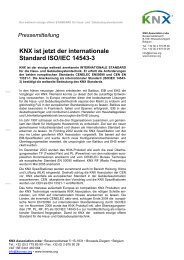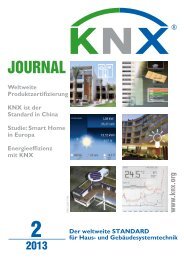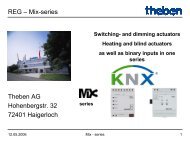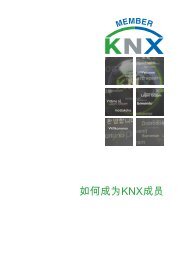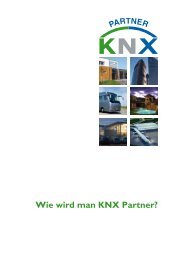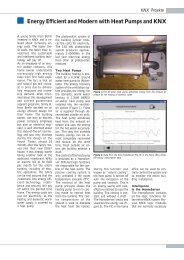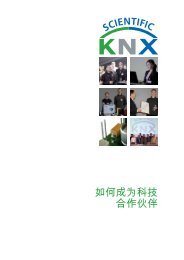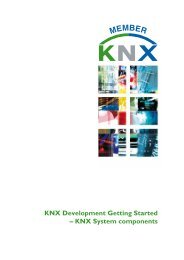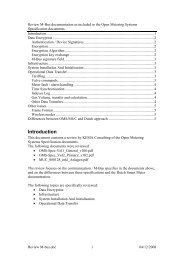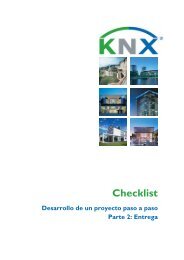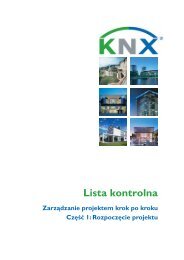KNX Journal 2011-1
KNX Journal 2011-1
KNX Journal 2011-1
You also want an ePaper? Increase the reach of your titles
YUMPU automatically turns print PDFs into web optimized ePapers that Google loves.
<strong>KNX</strong> Projects<br />
rity. The web-based visualisation<br />
makes manual operation<br />
available for employees. A<br />
menu can be consulted on<br />
each PC with Internet access,<br />
via which the perfect temperature,<br />
individual shading<br />
and lighting conditions at the<br />
workstation can be selected.<br />
A Decision With Foresight<br />
Increased efficiency year after year based on <strong>KNX</strong><br />
Calculation with sun<br />
and shade<br />
The operation of the entire<br />
building technology is carried<br />
out via the central building<br />
control. Timer programs for<br />
the lighting and room temperatures<br />
or setpoint values<br />
can also be set or modified.<br />
An astro program is used to<br />
control the sun protection of<br />
the facades. It thereby precisely<br />
calculates the solar radiation<br />
and shadows that move<br />
through the winding building<br />
complex during the course<br />
of the day. The shutters are<br />
protected against storm damage<br />
via wind sensors.<br />
The energy management<br />
system makes an essential<br />
contribution to the energy<br />
efficiency based on visualisation.<br />
It calculates the current<br />
cooling and heating demand<br />
for an effective generation of<br />
energy from climatic values<br />
and the heat requirements of<br />
the convector fans for an effective<br />
generation of energy.<br />
For this task, <strong>KNX</strong> communicates<br />
with the HVAC system<br />
via the SQL interface. The energy<br />
flows can be observed,<br />
documented and analysed via<br />
Smart Metering in order to<br />
use the determined values<br />
for further optimisation of<br />
the energy efficiency.<br />
A sensor-controlled sun protection system reduces the cooling load<br />
Everyone knows Hartmann<br />
bandaging materials. When<br />
the German textile manufacturer<br />
Paul Hartmann decided<br />
in favour of medical<br />
products in 1877, little did<br />
he know that his factory<br />
would someday become a<br />
multinational corporation<br />
for medicine and health<br />
care. When the Belgian<br />
branch office “N.V. Paul<br />
Hartmann AG” built its<br />
new logistics and administrative<br />
centre in Saintes<br />
in 1998, engineers at the<br />
corporate head office also<br />
showed they had foresight.<br />
They specified <strong>KNX</strong> (at<br />
that time still EIB) as the<br />
standard for the electrical<br />
installation. They realised<br />
that the flexible bus system<br />
had a future. The fact that<br />
high energy savings could<br />
be achieved on this basis<br />
at a later date with only<br />
a modest investment, was<br />
probably not taken into<br />
account back then.<br />
Successive expansion<br />
The first automatic functions<br />
monitored and controlled<br />
the lighting in the offices,<br />
corridors and outside areas<br />
partially via movement<br />
detectors. The blind drive<br />
mechanisms were likewise<br />
integrated in the bus system.<br />
Five years later, the engineers<br />
and system integrators of the<br />
Belgian site determined the<br />
versatile possibilities of the<br />
more sophisticated worldwide<br />
<strong>KNX</strong> standard for more<br />
efficient facility management.<br />
From 2006 onwards, the<br />
<strong>KNX</strong> functions were gradually<br />
extended: the lighting<br />
in the warehouses was given<br />
energy-saving constant<br />
lighting control. With the<br />
incidence of daylight, the<br />
lighting is no longer switched<br />
on at 100 percent but<br />
just with additional dimming<br />
values. Comfortable lighting<br />
conditions are thus achieved<br />
using less energy.<br />
In 2007 the blind controls<br />
were combined into a central<br />
system with weather<br />
stations. Unwanted heating<br />
of the rooms can be avoided<br />
through automatic shading.<br />
This in turn reduces the cooling<br />
load. At the same time,<br />
optimum daylight redirection<br />
History of the investments and the resulting energy savings<br />
Year Functions Costs € Total annual saving in % and €<br />
1999 Lighting and blinds 55.000.00 k.A k.A<br />
2005 First consumer analysis 0 0<br />
2006 Lighting in the warehouse, constant lighting control 1.246 -10,3 4.500<br />
2007 Automatic sun protection with weather station 2.000 -12,9 5.517<br />
2008 Central management<br />
4.000 -17,9 7.452<br />
Timers<br />
2009 Optimisation of the central management 1.000 -25,00 10.087<br />
<strong>Journal</strong> 1/<strong>2011</strong><br />
9




